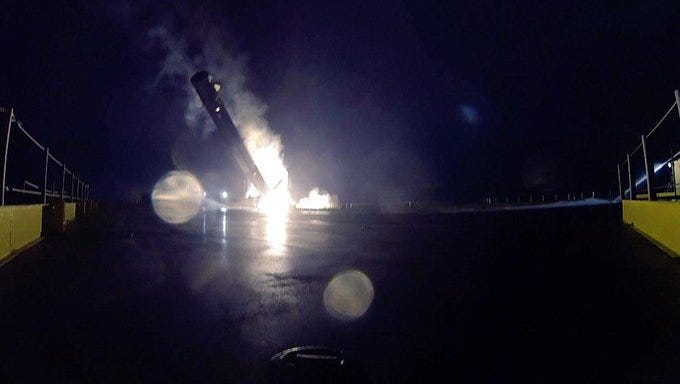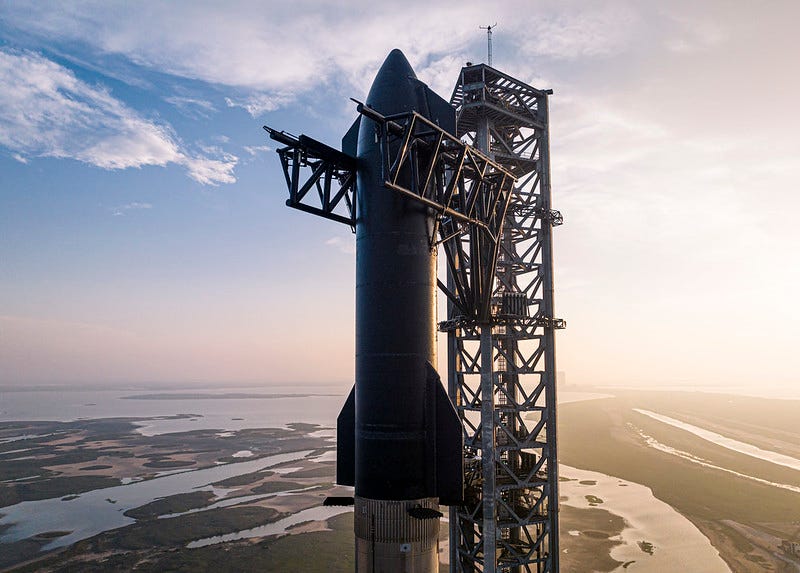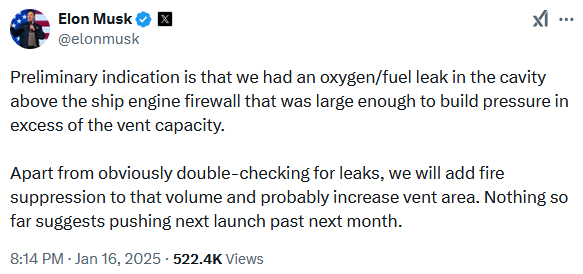A RUD Awakening
The latest "Rapid Unscheduled Disassembly" reminds us that the SpaceX Starship has the same limitations that doomed Space Shuttle crews
January 2015 … Falcon 9 crashes and explodes onto the deck of a SpaceX drone ship. Image source: Elon Musk on X.
A decade ago, when SpaceX kept crashing Falcon 9 boosters onto the deck of its drone ship as the company attempted to master landings, founder Elon Musk referred to one particularly fiery explosion as a “rapid unscheduled disassembly.” It was good for a laugh, but contrary to popular belief he didn’t originate the phrase. “RUD” was already in use on Kerbal Space Program forums, and was considered a variant of similar terms used for decades in the engineering trades.
The company’s willingness to embrace failure was all in the name of going faster. It was counterintuitive to the way government programs had run for decades. But it was also a return to the way government programs had once begun.
With a new administration taking office in Washington on Monday, January 20, one big question for the American space industry is if failure will not only be tolerated, but encouraged to the point of recklessness.
If At First You Don’t Succeed
In the 1950s, at the dawn of the Space Age, RUD was quite common. Computers and other means of simulation were quite crude compared to today. Metallurgy was nowhere near modern technologies. Rocket fuels were experimental at best. The only way to learn was to launch. If it worked, great, try it again and again to be sure. If it went kaboom, figure out why but keep on going.
A compilation of rocket and missile failures at Cape Canaveral in the 1950s. Video source: Cape Canaveral Space Force Museum YouTube channel.
That was only possible because the federal government was the piggy bank. The American taxpayer funded these tests in the name of national security.
By the 1960s, RUD became less and less common, but launch failures still happened now and then. One of the more famous anomalies was a Delta II launch from Cape Canaveral 28 years ago today, January 17, 1997. A solid rocket booster failed thirteen seconds after launch, raining down debris on the blockhouse and nearby museum.
RUD was counterintuitive to the NASA way of doing things. Contrary to popular belief, NASA in its early days didn’t own its rockets. The agency used spare Redstone, Jupiter, Thor, Atlas, and Titan launch vehicles. All of these were military rockets.
When Wernher von Braun and his Army Ballistic Missile Agency team in Huntsville, Alabama transferred to NASA in 1960, they brought with them a “super Jupiter” program called Saturn. Project Saturn was to develop more powerful rocket engines, but the Army was getting out of the launch business so it had no interest. NASA picked up the research, hoping that the technology might translate one day to next-generation boosters with more thrust.
On May 25, 1961, President John F. Kennedy proposed that the US place a man on the moon by the end of the 1960s. He knew that the US had several new launch vehicle options on paper, including a more powerful Saturn called the Saturn V. (It was originally called Saturn C-5, the fifth in the “C” series of developmental vehicles.)
Von Braun believed in an incremental approach, so Saturn built on existing Redstone and Jupiter technologies developed by ABMA. The Saturn I, Saturn IB, and Saturn V all had hiccups, but no RUDs during the years they flew, from 1961 through 1975.
In the movie Apollo 13, actor Ed Harris famously said, “Failure is not an option!” His character, Gene Kranz, never said that in real life, but the consequences of failure were drilled into NASA executives by the Apollo 1 fire on January 27, 1967. Astronauts Gus Grissom, Ed White, and Roger Chaffee died after a spark from frayed wiring ignited a fire that quickly spread due to the enriched oxygen air inside the spacecraft.
Before the fire, the NASA rank and file were American heroes. After the fire … the image had been tarnished.
After Apollo 13 was almost lost, President Richard Nixon decided to truncate Project Apollo. Three flights were dropped, with the last flight to be Apollo 17. He didn’t want to risk losing more astronauts, especially with his re-election campaign coming up in 1972.
Nixon declared that NASA would no longer enjoy its singular exceptionalism within the annual federal budget process. His March 7, 1970 space policy statement said that “space expenditures must take their proper place within a rigorous system of national priorities.”
Failures might lead to second-guessing, congressional inquiry, and perhaps cancellation. The era of risk-taking in the name of prestige was over.
A Complex and Risky System
A 1975 Marshall Space Flight Center design concept. Image source: NASA.
Out of that era of fiscal restraint came the Space Transportation System or, as we know it, the Space Shuttle. NASA promised that the Shuttle would be affordable, reliable, and safe. One early estimate projected that the Shuttle would fly 30, 70, maybe even 140 missions a year.
None of that turned out to be true.
Shuttle had three fundamental design flaws.
The first was that the orbiter was a glorified glider. It had wings and a tail just like an airplane, but no engines to fly on its own. Because it was a spaceplane, it needed those wings and the tail to fly while descending through the atmosphere. It also needed a runway.
Without all of that, the spaceplane and its crew would be lost — what NASA calls “a bad day.”
The second flaw was that the orbiter was too big to fit atop the rocket, so it had to be mounted on the side of its largest booster. This is called a “sidemount” design. Earlier designs put the crew capsule atop the booster; that’s called an “inline” design.
The third flaw was the lack of an escape system. Unlike the conical capsules of earlier eras, the orbiter’s crew cabin had no means of separating from a malfunctioning launcher. Depending on when in the flight the anomaly occurred, the orbiter’s pilots were to either turn around and fly it back to a landing at Kennedy Space Center, or continue downrange to an emergency landing site. Neither scenario was ever tested, much less proven.
Fourteen astronauts lost their lives during the Space Shuttle era — seven on Challenger and seven on Columbia.
Challenger was destroyed 73 seconds after launch, on January 28, 1986. When the external tank and solid rocket boosters exploded, the spaceplane orbiter disintegrated. The crew cabin tumbled into the ocean, killing the crew. The cabin had no escape system.
Columbia launched on January 16, 2003. During the launch, a piece of the external tank insulating foam struck the orbiter’s left wing, punching a hole about the size of a bowling ball. During re-entry, super-heated plasma entered the wing through the hole and melted its aluminum skeleton. Over Texas, the wing fell off, Columbia went into a spin, and the crew were lost. Because of the sidemount design, the orbiter was struck by falling debris during launch. It needed a runway to land, but it could not land, much less fly, without a wing.
The Columbia Accident Investigation Board report concluded:
Despite efforts to improve its safety, the Shuttle remains a complex and risky system that remains central to US ambitions in space.
What’s Past is Prologue
SpaceX was one of two companies that received commercial cargo contracts from the George W. Bush adminisration in December 2008, and one of two companies that received commercial crew contracts from the Obama administration in September 2014.
The cargo and crew Dragons, sitting atop a Falcon 9 booster, went back to the inline concept. In case of a failure, Super Draco thrusters built into the fuselage will propel the spacecraft away from the booster.
SpaceX certainly has had its share of failures. The Falcon 9’s predecesor, the Falcon 1, failed during its first three test launches at Kwajalein Atoll in the Pacific Ocean. Early Falcon 9 launches at Cape Canaveral had several near-misses.
October 7, 2012 … The first SpaceX Falcon 9 mission to the International Space Station loses an engine at 1:19 into the launch. Video source: Space SPAN YouTube channel and SpaceX.
A little more than a minute into its launch on October 7, 2012, a Falcon 9 blew one of its nine engines. The rocket kept going, and the cargo Dragon made its first operational International Space Station delivery.
Another ISS cargo delivery went awry on June 28, 2015. At 2 minutes 19 seconds after launch, the Falcon 9 upper stage exploded. The cargo Dragon’s Draco thrusters drove the spacecraft away from the anomaly, but the software had not been programmed to deploy landing parachutes. The Dragon cannonballed into the Atlantic Ocean, its payloads lost. An independent NASA review concluded that SpaceX had used an inferior helium bottle strut “without proper modeling or adequate load testing of the part under predicted flight conditions.”
June 28, 2015 … The SpaceX Falcon 9 explodes 2 minutes 19 seconds after launch. Video source: NASA’s Kennedy Space Center YouTube channel.
On September 1, 2016, the upper stage of a Falcon 9 exploded during a static test fire on the pad at Launch Complex 40. The payload, an Israeli communications satellite called AMOS-6, was destroyed. SpaceX had convinced the customer that, by placing the satellite on the booster before testing, it could launch sooner instead of having to bring the rocket back into the hangar for mating. The failure complicated a planned Spacecom merger with a Beijing company and cost Facebook its planned connectivity with Africa. Israel Aerospace Industries, the satellite’s manufacturer, compenated Spacecom $10 million for the loss of the satellite.
The Falcon 9 static test fire anomaly on September 1, 2016. Video source: USLaunchReport YouTube channel.
Despite the multiple early failures, the Falcon 9 evolved into a reliable and reusable launch vehicle. On January 10, 2025, a Falcon 9 launched and landed for the 25th time.
Customers continued to fly with SpaceX because the company was far cheaper than alternatives. Some customers purchase launch insurance to cover their losses in case of failure. Insuring a SpaceX launch may cost more, but that cost might still be far less than the additional expense of launching with a competitor. Other factors need to be considered, though, such as the loss of promised services, which is what happened with Spacecom due to the AMOS-6 anomaly.
A SpaceX Starship atop a Super Heavy booster on the launch pad at Boca Chica, Texas, April 15, 2023. Image source: SpaceX Flickr.
SpaceX has embarked on developing a new generation of launch vehicle, called Starship. The system has two parts — a Super Heavy booster, and an upper stage spacecraft also called Starship.
The company tests the system in Boca Chica, Texas at a complex called Starbase. They’ve had a number of spectacular failures, but have continued to make progress.
Yesterday’s launch successfully returned Super Heavy to its launch pad, captured by two arms attached to the gantry tower. Starship continued on its way to orbit, but stopped transmitting data about 8 1/2 minutes into launch.
Downrange near the Turks and Caicos Islands, civilians saw streaks of flaming debris pass overhead. Their smartphone photos and videos began to appear on social media.
A compilation of amateur videos that captured the remains of Starship IFT-7 streaking across the Atlantic Ocean. Video source: NBC News YouTube channel.
The videos evoked memories of similar images recorded on February 1, 2003, when Columbia was destroyed. Flaming debris streaked through the sky that day as well.
The loss of IFT-7 reminds us that Starship shares two of the three design flaws that compromised the Space Shuttle orbiter.
It’s an inline system, so Starship can’t be hit by falling debris during launch. But it’s a winged spacecraft like the orbiter, and it lacks an escape system. Starship doesn’t need a runway — it will be captured by a gantry tower, as was Super Heavy yesterday — but it relies on flaps and thermal protection tiles during re-entry. One flap nearly burnt through on IFT-5.
With a RUD such as yesterday’s anomaly, there’s no return to launch site, there’s no ejection system, there’s no parachute. Had crew been aboard, they would have perished, as did the Challenger crew.
If a flap fails on re-entry, the same applies. As with Columbia, the crew will be lost.
Buying a President
The Federal Aviation Administration announced today that it will examine the IFT-7 anomaly.
The FAA is requiring SpaceX to perform a mishap investigation into the loss of the Starship vehicle during launch operations on Jan. 16. There are no reports of public injury, and the FAA is working with SpaceX and appropriate authorities to confirm reports of public property damage on Turks and Caicos.
During the event, the FAA activated a Debris Response Area and briefly slowed aircraft outside the area where space vehicle debris was falling or stopped aircraft at their departure location. Several aircraft requested to divert due to low fuel levels while holding outside impacted areas.
Elon Musk doesn’t seem concerned, posting on X that he intends to be flying in a month.
One might dismiss this as “Elon Time,” the well-known phenomenon of Musk giving overly optimistic predictions for when an event might happen. An FAA investigation under normal circumstances might take months before a finding is reached and conditions imposed to resume test flights.
But we have a new administration in the White House come Monday January 20. According to media reports, Musk invested $277 million to elect Donald Trump and other Republican candidates. Trump will allow Musk and Vivek Ramaswamy to conduct independent investigations into how they think the government should be run. Needless to say, Musk will wield considerable power and influence within the government come January 20.
Trump has yet to nominate a new FAA administrator. In the meantime, an interim appointee will run the agency. What happens if Musk asks Trump to terminate the FAA investigation and certify Starship for flight? Will an interim appointee protect the rank and file?
Elon’s confidence that he’ll soon fly again might reflect his belief that he now runs the government through Trump.
Even if SpaceX fixes what caused this specific anomaly, the fundamental issues remain. What happens to crew if another failure occurs? Will there ever be an escape system? What if another flap fails? What if there’s no capture tower available to land?
Those questions remain unanswered. They should be before NASA allows a single astronaut aboard, and the FAA licenses crewed flights.




